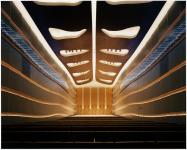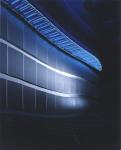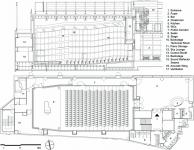Commissioned by a music amateur, the president of a Japanese Hi-Tech Medical Apparatus Manufacturer, the Hakuju Concert Hall project was won by Albert Abut at a limited competition. The Architect, originally associated with the Ove Orup consultancy firm, and later on with the special cell of the construction company Takenaka, had to focus on insulating the concert hall both from the noise of the building in which it has to be installed and from the noise of the bustling Shibuya area.
Beyond that, the settled target of the team project (especially the acoustician) was no less than reaching the acoustical level of the BramsHalle of the Muziksverein in Vienna. Considering the relatively tiny surface allotted, the traditional balconies found on the lateral walls of the BrahmsHalle, where they reflect sounds, were even not a choice. They would have reduced further the already small volume. Instead of them, Albert Abut used for the same purposes a combination of wings made of laminated glass – Glass Platz (Germany) – and transparent acrylic structural beams.
Besides the drastic requirements related to the acoustics on which the team worked with the acoustician of Takenaka, the project had to fit in an already fixed volume. Decided to change prejudices spectators and musicians might nourish about having a performance at the 7th floor of an anonymous office building, the Concert Hall design had to be as impressive as precious shoes in the shoe box system he was designed in. Drawing from his own experience – Abut had been project manager for the Andrault and Parat finalist team in the competition for the Cannes movies festival building in 1979 – as well as from pre-existing structures (such as the Fumihiko Maki Tsuda Hall in Tokyo, “great, but with such uncomfortable seats”, recalls Abut), the Architect thought of his Hall as a dreamlike structure. Seated in one of the 300 of which half are reclining seats, the spectator has the unusual sensation he is floating.
“In music, when notes are stopping suddenly, and move from one tempo to another, they take the listeners in a world that composers imagine and musicians interpret and that I as an architect had to transcribe into our three dimensional world. The transcription was materialized after sending sounds into a room in the midst of which was placed a sheet of paper with sand on it. With these different sounds the paper vibrated and the sand took different shapes reminding the structure of mouth of a manta ray or the belly of a whale, accentuating the feeling of a floating world in a universe of expanding and contracting sounds which give the visitors the impression that the hall seems alive… like the flux and the reflux of the tide.” Albert Abut
Everything from the walls to the ceiling was clad with glass-fiber reinforced cement panels to recreate the quality of the raw and roughly polished stones of the French and Italian churches in which the Architect used to attend classical music concerts.
Such a stunning cladding system is certainly not a fancy. Every form, every undulation of the walls and ceiling, even the way the three layers of fiber reinforced cement boards are laid in three different directions under a huge metallic structure hanging from the roof slab, was executed for acoustic reasons, such as to obtain the perfect shape for the best wave length”. 1.6 seconds reverberation interval throughout the hall: exactly the necessary time to allow music to charm your ears based on two essential acoustic factors : reflection and absorption.
A goal attained after the construction of a large-scale model tested at the Takenaka laboratories – the hall had to satisfy the acousticians calculations on 20 different frequencies – and later on final adjustments carried out during trial concerts the summer prior the opening. The tests helped determining further the shape of the voids in the ceiling, as well as its thickness. Narrower near to the stage, the ceiling is made out of two symmetrical planes, of each 4.5 m wide and 21 m long, with a variable thickness of 67 cm at wall junction; 57 cm at central point. Each panel has 8 holes of different sizes and shapes. Though, all of the holes are composed following the same system. Hanged from the true ceiling by metallic stalks each of the two planes design a C shape section, allowing the sound to rebound in the 42 cm cavity. The 5 longitudinal scratches of the walls also play an active role in the sound refraction. Their location and design had also been defined after the tests done in laboratories. 22 cm large at the back of the room there are wider close to the stage: 50 cm. As the ceiling, the wall thickness varies for similar reasons and gets 50 cm thicker close to the stage. Similar process had decided for the exact perimeter of the two glass wings manufactured by Glass Platz in Germany; their dimension being adjusted to reproduce the same sound refraction as the balconies in the BrahmsHalle. Larger at the center, each wing connects with the wall at the height of the 3rd scratch (3.6 m from the ground), through an acrylic plastic bone anchored in the wall every 46.5 cm. Thermo-formed glass, produced in Brittany (France), had been installed behind the stage wall where it reflects sound to the performers and then to the audience.
Shaped as a variable sizes box, in an insulated box, in the box of the building, the Hakuju Hall drives the music waves from the musician to the listener, with all the precision expected by the High-Tech used Tokyo Music amateurs. All had been controlled, and to avoid any possible interference with the noise of the city, rubber joists had been interposed between the floating part of the ceiling and the fixed one. Same thing with the stage, built in continuity with the stage wall, such as it is completely unplugged from the real floor.
2002
2003
location: Shibuya, Tokyo – Japan.
client: Hakuju Co., Ltd.
type: Public.
total floor area: Bldg. Entrance Hall + corridors, stairs, elevators, toilets + foyer + concert hall without the backstage areas = 740,35 m2
program: 360 seats concert hall, foyer and annex functions.
mission: Architecture, site & landscape, Lighting, Interior.
status: Completed.
date: 2002 – October 2003 (14 months).
Opening: October 4th, 2003
budget: US$ 3,8 Million.
internet: http://www.hakujuhall.jp
Architect: Albert ABUT
AA Project Team: Fadilha ABUT, Masayuki HATA, Shunsuke FUKUHARA, Akitomo TAKAMI
Construction: Takenaka Corporation
Acoustics Consultants: Ove Arup and Partners at competition stage and later Takenaka Corporation
Lighting concept:: Ove Arup/Albert Abut
Structural, Mechanical and Electrical Engineering: Takenaka Corporation
Detailed planning and construction supervision: Albert Abut/Atlantis Associates/Takenaka Corporation





